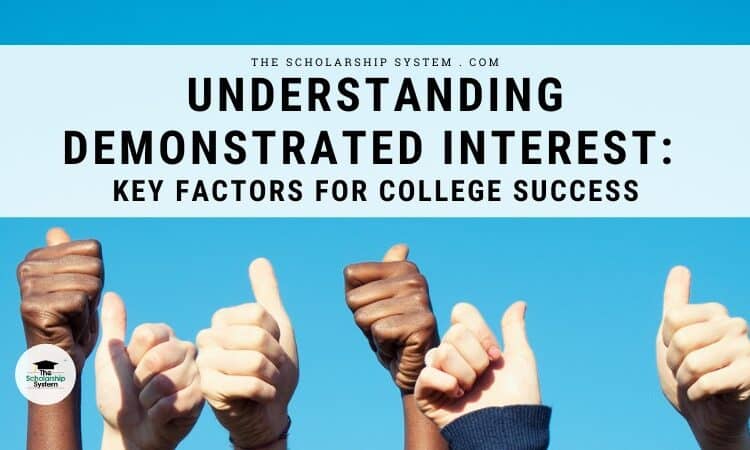Updated on March 31st, 2025
For students navigating the college application process, standing out can feel like a challenge. With thousands of applications pouring in each year, colleges are looking for more than just strong grades and test scores. They want students who are genuinely excited about joining their community – those who take the time to visit campus, engage with representatives, or show enthusiasm in meaningful ways. This is where demonstrated interest comes into play, giving students an opportunity to make a lasting impression beyond their transcript.
If your student wants to find scholarship opportunities to make paying for college manageable, we can help! Sign up for our free college scholarship webinar to learn more about the scholarship process! Head over to http://thescholarshipsystem.com/freewebinar to reserve a spot today.
While many students may be familiar with the term demonstrated interest, its true meaning and importance in the college admissions process are often misunderstood. While academic achievements and extracurricular activities play a significant role in admissions decisions, colleges often look deeper when evaluating applicants. Admissions officers want to admit students who are not only qualified but also eager to contribute to campus life. When two students have similar academic profiles, the one who has made an effort to connect with the school may have an edge in the decision-making process. Understanding how to effectively showcase enthusiasm for a school can make all the difference in securing a spot at a dream college. Some colleges track demonstrated interest but do not use it as a factor in their admission decisions.
Contents
- 1 What is Demonstrated Interest?
- 2 Why Colleges Track Demonstrated Interest
- 3 Ways to Show Demonstrated Interest
- 4 The Role of Demonstrated Interest in College Admission
- 5 How to Communicate with Admissions Counselors
- 6 Demonstrated Interest and Early Decision
- 7 Demonstrated Interest and College Fit
- 8 Best Practices for Demonstrated Interest
- 9 Common Mistakes to Avoid
- 10 Conclusion
What is Demonstrated Interest?
When a high school student applies to a college, simply submitting an application is not always enough to stand out. Demonstrated interest refers to the additional steps taken to show genuine enthusiasm for attending a particular school. It goes beyond stating a preference and involves proactive efforts such as attending events, engaging with admissions representatives, and researching specific aspects of the institution. Students can show interest in a college by attending college fairs and touring the campus. Colleges appreciate when students make an effort to learn more about their programs and campus culture, as it signals a strong level of commitment.
For applicants hoping to strengthen their connection with a school, demonstrated interest is a critical factor to consider. Admissions teams recognize when a student takes extra steps to engage, whether through visits, virtual events, or meaningful application materials.
Unlike simply applying, which may be done on a broad scale, showing interest requires intentional actions that indicate a student is serious about enrolling. When schools decide who to admit, they may consider these efforts as an indication of how likely a student is to accept an offer of admission.
Why Colleges Track Demonstrated Interest
With an increasing number of students applying to multiple schools, admissions teams seek ways to identify those who are genuinely interested in enrolling. Since each incoming class shapes the future of the institution, colleges track demonstrated interest to determine which students are most likely to contribute to their community. Enthusiastic applicants are more likely to remain engaged, participate in campus activities, and thrive academically, making them valuable additions to the student body.
Another reason colleges focus on engagement is to protect their enrollment data. Every year, schools carefully manage their acceptance rates and yield rates, which measure how many admitted students ultimately decide to attend. A high yield rate is a sign of a well-targeted admissions strategy, and students who have shown a commitment to the school are more likely to enroll. For this reason, demonstrated interest can play a role in shaping admissions decisions.
The admissions office considers multiple factors when reviewing applications, but demonstrated enthusiasm can sometimes tip the scales in favor of one applicant over another. When students attend events, connect with representatives, or tailor their application materials to highlight specific programs, it provides valuable insight into their motivation. While not every school weighs this factor equally, it can be an advantage when admissions teams decide who to admit from a highly competitive pool.
Ways to Show Demonstrated Interest
One of the most effective ways to express enthusiasm for a university is through well-researched application materials. A strong essay should reference specific classes, professors, or campus traditions that align with a student’s interests. Admissions teams value thoughtful responses that demonstrate an understanding of what makes the school unique.
Similarly, attending an information session or engaging with faculty and current students can provide valuable insights while also signaling genuine interest. For high school students looking to make an impression, taking part in outreach opportunities is key. A campus visit offers the chance to explore facilities, attend lectures, and engage with admissions representatives in person. Students should also register for college visits and events to show their interest.
When an in-person visit isn’t possible, virtual events and college fairs provide alternative ways to learn about a school. Following social media accounts and regularly opening emails from admissions offices can also help students stay informed and show continued interest. Engaging with the content by clicking on links within emails to learn more about specific programs can demonstrate interest.
Interacting directly with admissions representatives and ensuring emails are opened can also leave a lasting impact. Many schools offer college admission counseling sessions where students can ask detailed questions about academic programs, student life, and application expectations.
By taking these extra steps, students can make it clear that they are not just applying to a college – they are excited about the possibility of becoming part of its community.
The Role of Demonstrated Interest in College Admission
When evaluating applicants, colleges consider a range of factors, from academic performance to extracurricular involvement. Alongside transcripts and test scores, college admission offices often take demonstrated interest into account to gauge a student’s enthusiasm for attending. A strong academic record may open doors, but a student’s proactive engagement with a school can help solidify their place in the applicant pool.
Admissions officers track demonstrated interest through various interactions, such as a student’s engagement with emails, attendance at virtual or in-person events, and direct communication with representatives. Colleges track students’ attendance at events like college fairs and campus tours, and keep records of students they have interacted with during recruitment events. Actions like visiting campus, participating in an information session, or even interacting with a school’s social media content can indicate sincere enthusiasm for the institution.
While not all schools weigh interest equally, showing a consistent and meaningful connection with a university can make a difference in a competitive admissions process. However, demonstrated interest is not a make-or-break factor in admissions decisions, as other elements like academic performance and extracurricular achievements often carry more weight.
How to Communicate with Admissions Counselors
Reaching out to the college admissions team to interact and gather crucial details about a school is a valuable opportunity to express interest. Students can make these conversations more impactful by asking thoughtful questions that go beyond basic facts. Inquiries like “What makes the student community unique?” or “What support services are available for new students?” show genuine curiosity and allow for more meaningful discussions. Plus, taking the time to personalize interactions demonstrates both enthusiasm and preparation.
At the same time, students should be mindful of how frequently they contact admissions officers. While it’s beneficial to engage with counselors, excessive emails or repeated inquiries can come across as overzealous. Respecting their communication style is vital, as they manage interactions with thousands of prospective students. However, in cases where a student is on a waitlist or awaiting an admissions decision, it’s appropriate to check in with the admissions office for updates on application status.
Demonstrated Interest and Early Decision
Choosing to apply early through early decision or early action can send a strong signal of commitment to a school. These admission plans require students to be proactive in their application process and often demonstrate a level of enthusiasm that standard applications may not convey. Colleges recognize that students who apply through these programs are highly motivated and likely to enroll, which can make them more appealing candidates.
When a student commits to a university as their first choice, it reinforces their demonstrated interest in a meaningful way. Admissions teams understand that students who select early decision have thoroughly researched their options and are fully dedicated to attending if accepted.
While early action doesn’t carry the same binding agreement, it still showcases a strong level of engagement. For students who are confident in their choice, applying early can be a strategic way to highlight enthusiasm and commitment.
Demonstrated Interest and College Fit
When colleges evaluate applications, they look beyond academic credentials to determine if a student is a good fit for their institution. Demonstrated interest plays a role in helping admissions teams gauge whether a student’s enthusiasm aligns with the school’s values and offerings.
A student who actively engages with a school, attends events, and personalizes their application materials signals a genuine desire to be part of that academic community. This level of commitment can strengthen an application by showing that the student is not just applying broadly but has a deep interest in a particular college. Students should hang onto valuable emails and resources that contain useful information for their college search process.
There are many ways students can express their enthusiasm for a school, and both virtual and in-person connections can make an impact. While a campus visit allows students to experience the environment firsthand, attending online sessions, engaging with faculty, or participating in social media discussions also demonstrates a commitment to learning more about the institution. Schools value students who take these extra steps because it shows they are serious about attending and have taken the time to ensure the university is the right fit.
Best Practices for Demonstrated Interest
Being intentional about engaging with a school is key to making a meaningful impression on the admission committee. Instead of sending generic emails or liking random social media posts, students should focus on genuine interactions.
Attending virtual events, asking insightful questions during information sessions, and responding to admissions communications thoughtfully can all signal authentic enthusiasm. Personalizing application materials to highlight specific programs, faculty, or campus traditions also helps demonstrate a true connection to the college.
A high school student can further show interest by staying up to date with the school’s latest news and developments. Regularly visiting the college website, opening emails from admissions teams, and participating in social media discussions all contribute to building a connection with the school.
If possible, visiting the campus or attending an official event can reinforce demonstrated interest, as firsthand experiences allow students to engage with faculty, current students, and admissions representatives in a meaningful way.
Common Mistakes to Avoid
While engaging with a school is essential, excessive communication with an admissions counselor can have the opposite effect. Sending too many emails, asking redundant questions, or contacting multiple representatives repeatedly may come across as overbearing rather than enthusiastic. Students should aim for thoughtful and purposeful interactions, ensuring that each conversation adds value to their understanding of the school and its programs.
Another common mistake is engaging with admissions materials in a superficial way. Simply opening emails or clicking links multiple times without actually reading the content does not demonstrate genuine enthusiasm. Similarly, conversations with representatives should go beyond basic inquiries about deadlines or application requirements. The admission committee appreciates students who take the time to ask meaningful questions and express a sincere interest in what makes a university unique.
Conclusion
In the competitive admissions process, taking the time to show authentic enthusiasm for a school can make a difference. Demonstrated interest helps colleges identify students who are not only academically qualified but also eager to contribute to campus life. Engaging with admissions teams, attending events, and crafting thoughtful application materials are all ways to reinforce a strong connection with a school.
For students looking to maximize their chances of acceptance, following best practices while avoiding common mistakes is essential. A well-planned approach to showing interest in a college can set an applicant apart and highlight their commitment to joining the school community. By taking proactive steps and demonstrating a sincere desire to attend, students can strengthen their applications and increase their likelihood of admission.
If your student wants to find scholarship opportunities to make paying for college manageable, we can help! Sign up for our free college scholarship webinar to learn more about the scholarship process! Head over to http://thescholarshipsystem.com/freewebinar to reserve a spot today.








Leave a Reply